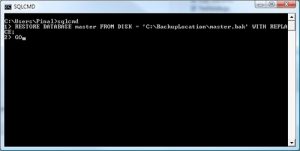
When you want to start the SQL Server service from SQL Server Configuration Manager, you will see an error as follows.

The need to restore the master database usually begins with the failure to open the sql server service as a result of a corruption in the master database. You can get detailed information about system databases in my article “ SQL Server System Databases” So how do we restore the master database when it is corrupted? Therefore, you should regularly back up the master database and other system databases. Therefore, without a master database, a sql server instance does not work. For example, logins, endpoints, linked servers, system configuration settings. Once you bring the instance back up you will need to re-patch back to your original level.Master database is a database that keeps all the information at the system level in an instance. One way around this is to create your new instance, shut it down, and copy the master.mdf, mastlog.ldf, MSDBData.mdf and MSDBLog.ldf files to the locations they exist for the instance (copy/rename the originals first of course).

Here is some light reading on the subject for you.īack Up and Restore of System Databases (SQL Server)Īlso I should point out that you can only restore master and possible msdb on an instance that is the exact same build number. If you've never made any changes to it you can probably skip it, but it doesn't hurt to bring it along also. master primarily will be your logins and list of databases. In fact msdb will contain all of your jobs and any ssis packages that you have stored in the instance. If you want to move the entire instance you can backup and restore the system databases, but make sure you get more than just master. You can refer to my script at ( make sure you do a backup restore and not detach/attach method - now learned it !!).



 0 kommentar(er)
0 kommentar(er)
